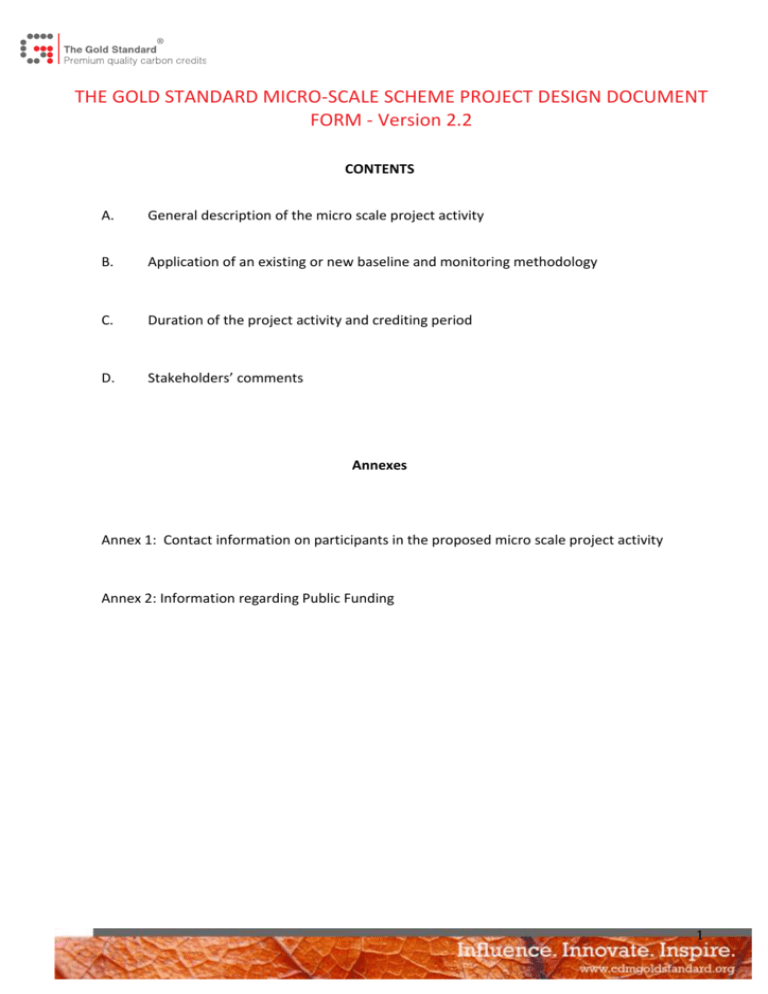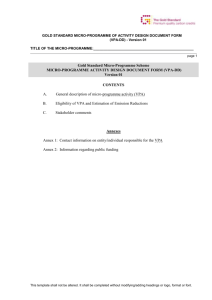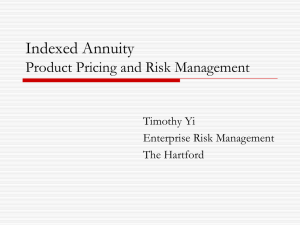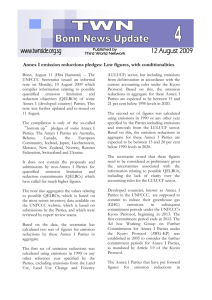Annex AP: Micro-scale Project Design Document
advertisement

THE GOLD STANDARD MICRO-SCALE SCHEME PROJECT DESIGN DOCUMENT FORM - Version 2.2 CONTENTS A. General description of the micro scale project activity B. Application of an existing or new baseline and monitoring methodology C. Duration of the project activity and crediting period D. Stakeholders’ comments Annexes Annex 1: Contact information on participants in the proposed micro scale project activity Annex 2: Information regarding Public Funding 1 SECTION A. General description of micro-scale project activity A.1 Title of the micro-scale project activity: >> Title >> Date & version of the PDD A.2. Project participants: >> A.3 Description of the micro-scale project activity: A.3.1. Location of the micro-scale project activity: >> A.3.1.1. Host Country: A.3.1.2. Region/State/Province etc.: A.3.1.3. City/Town/Community etc: >> >> >> A.3.1.4. Details of physical location, including information allowing the unique identification of this micro-scale project activity: >> A.3.2. Description including technology and/or measure of the micro-scale project activity: >> A.3.3 Estimated amount of emission reductions over the chosen crediting period: >> A.3.4. Public funding of the micro-scale project activity: >> Please refer to ODA declaration form (Annex D) 2 SECTION B. Application of an existing baseline and monitoring methodology or of a new methodology submitted as part of this project activity B.1. Title and reference of the existing or new baseline and monitoring methodology applied to the micro-scale project activity: >> B.2 Justification of the choice of the methodology and applicability: >> B.3. Description of the project boundary: >> B.4. Description of the baseline and its development as per the chosen methodology: >> B.5. Description of how the anthropogenic emissions of GHG by sources are reduced below those that would have occurred in the absence of the registered micro-scale project activity: B.6 Emission reductions: B.6.1. Explanation of methodological options or description of new proposed approach: >> B.6.2. Data and parameters that are available at validation: >> (Copy this table for each data and parameter) Data / Parameter: Data unit: Description: Source of data used: Value applied: Justification of the choice of data or 3 description of measurement methods and procedures actually applied: Any comment: B.6.3 Ex-ante calculation of emission reductions: >> B.6.4 Summary of the ex-ante estimation of emission reductions: >> Year Estimation of Estimation of Estimation of Estimation of overall project activity baseline emissions leakage (tCO2) emission reductions emission (tCO2) (tCO2) (tCO2) Year 1 Year 2 Year 3…. Total (tCO2) B.7 Application of a monitoring methodology and description of the monitoring plan as per the existing or new methodology applied to the micro-scale project activity: B.7.1 Data and parameters monitored: (Copy this table for each data and parameter) Data / Parameter: Data unit: Description: Source of data to be 4 used: Value of data Description of measurement methods and procedures to be applied, inc. frequency: QA/QC procedures to be applied: Any comment: B.7.2 Description of the monitoring plan: >> B.8 Date of completion of the application of the existing or new baseline and monitoring methodology and name of the responsible person(s)/entity(ies) >> SECTION C. C.1 Duration of the project activity / crediting period Duration of the project activity: C.1.1. Starting date of the project activity: >> C.1.2. Expected operational lifetime of the project activity: >> C.2 Choice of the crediting period and related information: C.2.1. Renewable crediting period C.2.1.1. Starting date of the first crediting period: >> 5 C.2.1.2. Length of the first crediting period: >> C.2.2. Fixed crediting period: C.2.2.1. Starting date: C.2.2.2. Length: >> >> SECTION D. Stakeholders’ comments >> Please note that the blind scoring exercise during stakeholder consultation need not be carried out. D.1. Brief description how comments by local stakeholders have been invited and compiled: >> Please describe the agenda of physical meeting, Non-technical summary, Invitation tracking table, Text of invitations sent, any other consultation method used D.2. Summary of the comments received: >> Please describe the outcome of the meeting, assessment of stakeholders comment, list of participants. D.3. Report on how due account was taken of any comments received and on measures taken to address concerns raised: >> Please discuss how the stakeholder’s comments have been addressed and include the changes to the design of the programme based on their feedback. D.4. Report on the Continuous input / grievance mechanism: >> 6 Discuss the Continuous input / grievance mechanism expression method and details, as discussed with local stakeholders. Method Chosen (include all known details e.g. location of book, phone, number, identity of mediator) Justification Continuous Input / Grievance Expression Process Book Telephone access Internet/email access Nominated Independent Mediator (optional) All issues identified during the crediting period through any of the Methods shall have a mitigation measure in place that should be added to the monitoring plan. D.5. Report on stakeholder consultation feedback round: >> 7 Annex 1 CONTACT INFORMATION ON PARTICIPANTS IN THE PROJECT ACTIVITY Organization: Street/P.O.Box: Building: City: State/Region: Postfix/ZIP: Country: Telephone: FAX: E-Mail: URL: Represented by: Title: Salutation: Last Name: Middle Name: First Name: Department: Mobile: Direct FAX: Direct tel: Personal E-Mail: 8 Annex 2 - Information regarding Public Funding 9








